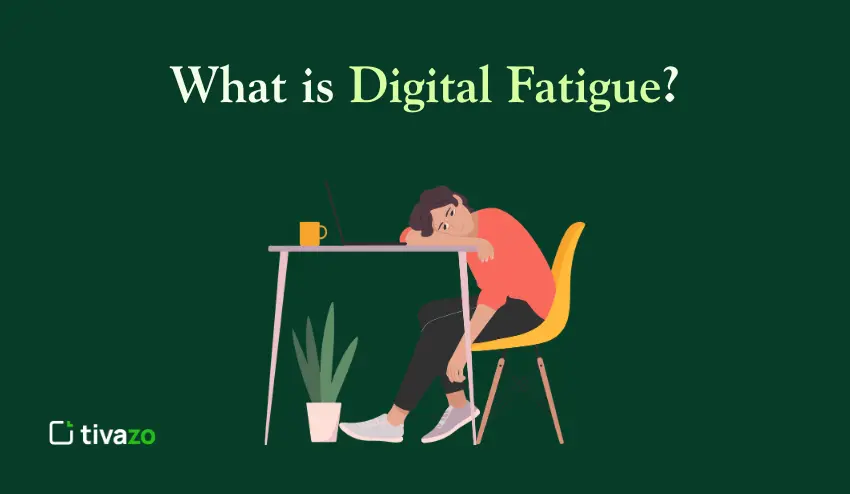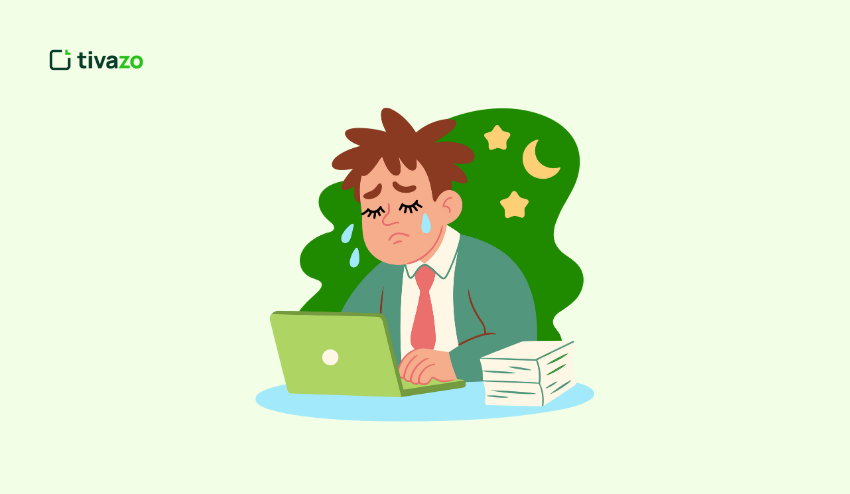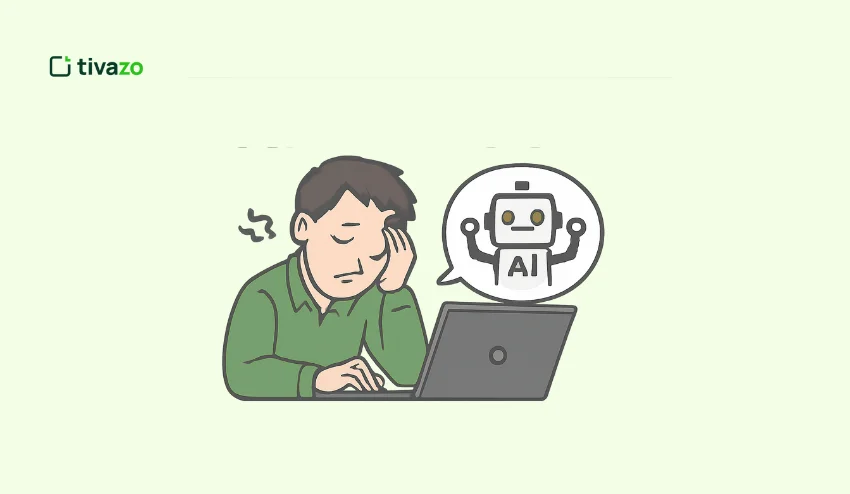Employees are leaping between screens every day, in spreadsheets, Slack messages, video calls, and full inboxes. At the close of the day, they have blurred eyes, lack concentration and are unmotivated. It is not merely a symptom of overwork, it is a silent productivity killer known as digital fatigue.
Digital fatigue is the psychological strain accumulated as a result of being on the screen and communicating online. It is the consequence of the digital tools that are supposed to simplify work beginning to flood our senses. This exhaustion silently kills concentration, imagination, and health in workplaces where virtual communication is a significant part of the work process.
With the advent of technology, which is becoming inevitable in our day to day work, the knowledge and handling of digital fatigue has become the crucial element in any contemporary office. In this guide, we will discuss the causes of it, its impact on employees and managers, and the steps that you can actually implement to overcome it without losing touch with the tools that make your business work.
What Is Digital Fatigue?

Digital fatigue is a psychological overload that is brought about by excessive use of digital devices and screens. It happens when the brain is overburdened with numerous notifications, back-to-back video calls, multitasking in several applications, and spending too much time on screens.
Digital fatigue in the contemporary office is not necessarily manifested in sore eyes. It impacts on the concentration, memory, and decision making. After work, employees can be distracted, irritable or even exhausted. To managers, digital fatigue may be manifested as reduced team interaction, deadlines, and reduced productivity.
The importance of combating digital fatigue at the workplace
1. Influence on Workforce Productivity.
Focus and efficiency are impacted by digital fatigue. Workers are mentally fatigued after spending more time on the screen, thus, tasks are harder to accomplish, and more mistakes are made. In the long run, this will lower productivity in general and may result in frustration or burnout.
2. Impact on Innovative thinking and problem solving.
Too much online communication may kill creativity. Constant interruptions and multitasking do not allow one to engage in deep work, which makes it more difficult to come up with new ideas or address complicated issues.
3. Team Interaction and Cooperation.
Exhausted employees will not be willing to attend meetings and give ideas. Such a disengagement may be contagious within the team, reducing collaboration, morale, and energy at the workplace.
4. Implications for Managers
Digital fatigue poses a problem to managers when it comes to managing teams. Less engagement and performance problems should be monitored and intervened with, increasing stress on the leaders. The proactive approach to dealing with digital fatigue assists managers to have a team that performs highly and is motivated. The initial stage of dealing with digital fatigue is to know its meaning. The knowledge of its symptoms and how it impacts working performance will help employees and leaders to be proactive in reducing the mental pressure and be focused throughout the working day.
Common Signs of Digital Fatigue at Work
Early identification of digital fatigue will enable employees and managers to avoid burnout and remain productive. It influences behavior, body, and emotions. This is how it manifests itself in the workplace:
1. Behavioral Signs
- Focus problems: Jobs that would otherwise require a couple of minutes are more challenging, and it is simple to be distracted by emails, notifications, or any other small distractions.
- Higher procrastination: Even the most significant work is postponed as the brain becomes congested and the speed of making decisions decreases.
- Reduced attention span during meetings: Virtual meetings that are long or multitasking on multiple platforms may result in the inability to remain attentive and capture information.
2. Physical Signs
- Eye strain and visual discomfort: Hours in front of the screens lead to dry eyes, blurred vision, and light sensitivity.
- Headaches and tension: The pain in the neck, shoulders and head may arise due to the long time sitting in front of the screen and constant attention.
- Constant fatigue: Feeling too tired at the end of the day despite a good sleep since the brain has not gotten a good mental rest.
3. Emotional Signs
- Irritability and frustration: Small things are exaggerated and there is a diminished tolerance toward coworkers or the nature of work itself.
- Feeling overwhelmed or anxious: There is always the feeling there is never enough time, due to the demands of always being connected digitally.
- Loss of motivation: Tasks which were once enjoyable are tiring, even the prospect of working on projects or with a team lacks interest now.
When employees and managers understand these signs, they can notice workers facing digital fatigue and proactively offer some ideas to lessen the impact of digital fatigue on performance and overall well-being.
Top Reasons for Digital Fatigue in the Workplace
Digital fatigue can’t just happen, it builds up slowly. Employees spend more and more time using different screen devices, whether it’s computers, laptops, phones, or switches, without taking breaks or balance. Below are the factors that contribute to digital fatigue in modern offices.
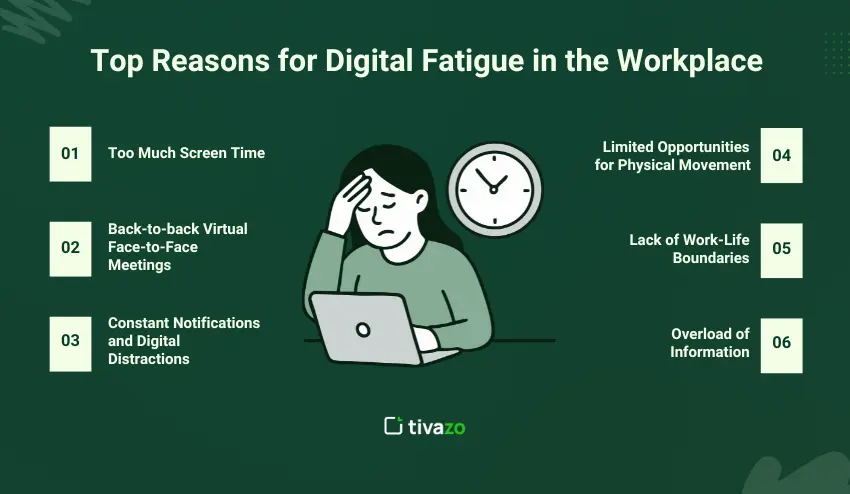
1. Too Much Screen Time
Most employees work for over 8 hours daily on computers, attending virtual meetings, and checking phone messages. The constant bombardment of screen devices is hard on people’s eyes and brain, leaving little time for brain recharging and rest, and this inevitably can increase digital fatigue.
2. Back-to-back Virtual Face-to-Face Meetings
Virtual calls may have replaced office meetings; however they are significantly more tiring. Continuous online meetings require sustained focus, facial engagement, and multitasking, all of which drain cognitive energy anytime we have to be “on.” These cognitive demands can lead to quick burnout.
3. Constant Notifications and Digital Distractions
Slack, email, and apps will all take employee focus throughout the day. This “always on” mode requires employees to switch their context on a daily basis which will impact productivity and cause fatigue if they are unable to concentrate.
4. Limited Opportunities for Physical Movement
Digital-based work often has employees remaining glued to desks. Without sufficient breaks to stand up to stretch, walk, or simply rest their eyes, or relieving discomfort, physical discomfort and mental exhaustion worsen.
5. Lack of Work-Life Boundaries
Through remote and hybrid work, numerous employees find it difficult to disconnect or create work-life boundaries. Responding to emails after hours or “checking in” on work during personal time keeps your brain in “work mode,” and fails to recover, even resulting in further fatigue.
6. Overload of Information
Anyone who has to sift through the volume of emails, updates and reports every day can experience cognitive overload. Consuming information throughout the day without taking time to process simply leads to mental exhaustion.
Once managers and teams understand the causes of mental fatigue, it nice to be aware of what causes the fatigue, and then possibly take action to address fatigue as a group in the workplace.
Digital Fatigue in Remote and Hybrid Work
While having a remote or hybrid working model can provide flexibility, it also poses increased risks of digital fatigue. Employees working from home may find themselves on the screen longer, attending extended virtual meetings, or having other complications of a work context that may spill-over into their personal lives.
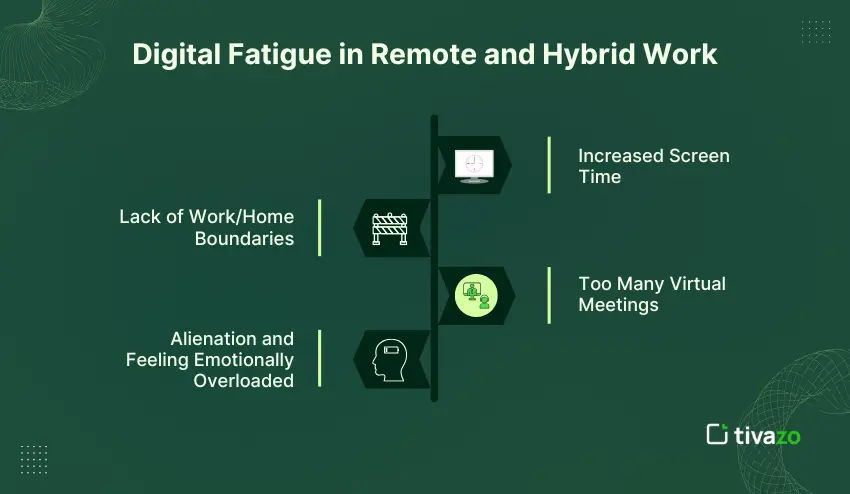
1. Increased Screen Time
Employees working from home engage in virtual meetings, instant messaging (e.g., Slack), and various collaborative work platforms. Since employees can no longer interact in an office environment, their screen time can extend beyond a traditional workday hours, resulting in significant cognitive fatigue.
2. Lack of Work/Home Boundaries
Employees who work from home have a workspace inside their living space, making it more difficult to disentangle them and disengage. Employees can check emails late at night or attend to messages over the weekend, which minimizes their brain’s ability to sufficiently reset and reduces their capacity to engage in productive work when tired.
3. Too Many Virtual Meetings
It is not the norm for employees to be in meetings for most of their traditional working day, which is the situation for most remote employees if managers do not proactively schedule them. When remote employees regularly stare at various faces on a screen for 30 minutes or longer, and listen without any break from listening, they may deplete their cognitive energy faster than they would in person.
4. Alienation and Feeling Emotionally Overloaded
Being socially isolated and unable to see someone face-to-face is likely to increase a sense of separation that may add to the difficulty in processing and coping with stress and the motivation and persistence related to rights-based activities. The emotional load of a socially isolated person, on top of the cognitive load of excessive screen time, will raise the overall cognitive load.
Strategies for Managing Digital Fatigue in a Remote Setting.
- Clarify boundaries – Define the start and stop times of work and discuss it with your team.
- Use asynchronous communication – Decrease missed meetings as much as possible and summarize in shared documents or a project management tool.
- Schedule breaks from the screen. Stand up from your computer at least every hour for a few minutes. Eye exercises or even a quick walk can begin to refresh your attention.
- Encourage “camera off” times – Provide a camera-free time during the day, to accomplish the work.
By developing and ‘using’ these strategies, remote or hybrid teams will continue to work productively while conserving mental energy and focus.
The Neuroscience of Digital Fatigue
Digital fatigue is not simply a sensation; it has legitimate effects on the brain. Learning about the science will assist employees and managers to better understand that a seemingly insignificant number of notifications and/or activating events, multitasking, or a line-up of back-to-back meetings takes mental effort to switch from task to task and that executive functions, concentration, attention, and information recall can be draining activities.
1. Cognitive Overload
The brain has limited attention span and processing ability. Repeated notifications, multitasking, and back-to-back meetings force the brain to switch tasks, sometimes at an alarming rate. Repeated “task-switching” wears down mental energy which makes it difficult to concentrate and recall information.
2. Dopamine and Reward Pathways
Every time there is a change in the environment that elicits the brain to receive a notification or email, the brain releases some dopamine that creates small bursts of satisfaction. After a while, these tiny doses of dopamine can overstimulate the reward pathways in the brain and render a deficient ability to focus on the sustained nature of meaningful tasks.
3. Visual and Sensory Drain
Increased periods of viewing a screen contributes to symptoms of eye strain, blurred vision, and headaches. That is because the brain has to work even harder to process continuous input from visual field, resulting in even more fatigue.
4. Activation of the Stress Hormone
Having a large workload or constant connectivity to coworkers through digital means, creates cortisol release – the stress hormone in the body. Continually elevating cortisol in the body can lead to cognitive inflexibility, heightened anxiety, and ultimately decreased ability to sustain focus in one’s work throughout the day.
Now, with all this information it becomes clearer for employees and managers to see that breaks, times for focused work, and reducing notifications aren’t just incidental tasks, they are necessary for protecting the brain, and performance while at work.
How to Reduce Digital Fatigue?
Decreasing digital overload will take focused approaches to address your personal habits and your workplace habits. Here are some simple strategies for you (as an employee) and your managers to consider:
1. Audit Your Digital Life
Begin tracking the time you are engaged in technology, which includes screens, meetings, and messaging. Using time tracking software like Tivazo can help you keep log of all the activities and time you’re spending digitally. Take note of periods of time in the day that feel stressful; capture any notifications that seem unnecessary.
2. Change Meeting Etiquette
Shorter, more focused meetings are encouraged and avoid duplicate updates in a meeting setting as much as possible. Turn meetings into synchronous updates
3. Remember to Take Eye Breaks Every Hour
Every hour you need to find a short break to look away from the screen, stand and stretch, and if possible, walk for a few minutes. Techniques like the Pomodoro Method or eye exercises can assist in sustaining mental acuity and fortitude while on a screen.
4. Promote “Tech-Free” Times
Create periods of time each day when employees do not have to check emails or respond to messages. This is meant to help the brain rest from the constant barrage that accompanies a person’s day.
5. Optimize your Workstation
Adjust near your chair, desk and monitor to decrease strain on the body. Proper lighting, posture and monitor distance can significantly increase overall wellness while decreasing headaches and referring swollen eyes.
6. Use Tools to Combat Overload
Use technology tools that will condense the notifications, summarize emails, and block distractions. Use a focus timer, for example, or enable your “do not disturb” feature, so you can stay focused.
Conclusion
Digital fatigue is an increasing challenge of the modern workplace that causes distractions, reduces productivity, and impacts an employee’s overall health. Digital fatigue can plague in-office employees, remote workers, and hybrid employees that are constantly exposed to screens, have numerous back-to-back meetings, and/or work-life balance boundaries are blurred.
The positive news is that digital fatigue can be managed. Understanding what causes it, recognizing its signs, and implementing realized and practical strategies in the workplace will allow employees and managers to maintain their focus as well as achieve a healthier and more productive work environment, such as scheduled breaks, time free of technology, and a more optimized culture of meetings.
